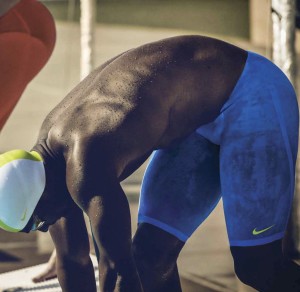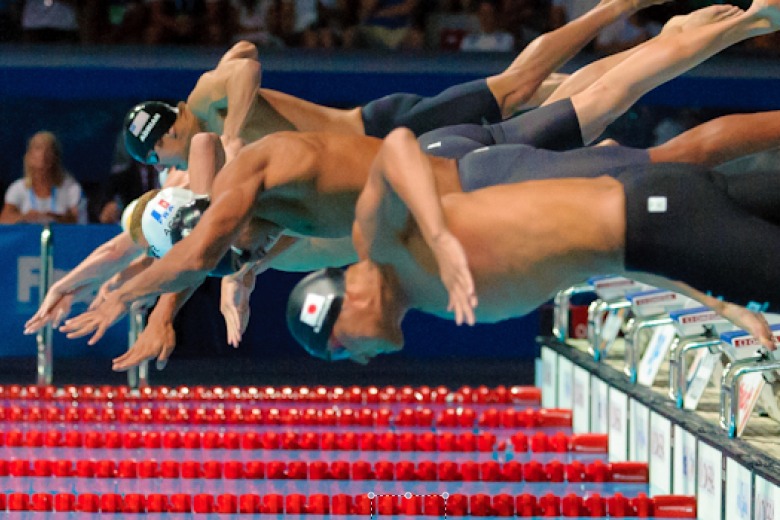Eric McGinnis is the Rollins College Strength & Conditioning Coach and Sports Performance Specialist, a former Kentucky All-American and World University Games gold medalist, and the brother of former Virginia Tech All-American Zach McGinnis. He also is a trainer at Spectrum Sports Performance. Follow him on Twitter here and on Facebook here.
Everybody wants to be a sprinter, but any experienced swimmer knows that swimming fast can be harder than it looks. Here are five tips, in no particular order, that can help you with your speed problems.
 1. Know The Details
1. Know The Details
Sprinters rarely have to endure the boredom of swimming endless laps on a day-to-day basis. The trade-off is, as a sprinter, you need to be extra dialed in to the “boring” details that make up perfecting your race. These include, but are not limited to, tempo, stroke cycles, number of dolphin kicks off the start and turns, and timing of the breakouts. One of the beautiful things about swimming is that, for the most part, you ALWAYS know what to expect on race day. It’s not unpredictable like team sports, which means you should know exactly what to prepare for and what works best for you.
2. Don’t Get Carried Away With Lactate Sets
Let me be clear, I’m not against preparing the body for lactate threshold. However, lactate sets have become overly trendy and are often marketed as both “sprinter workouts” and “mental toughness workouts”. When you do overly aggressive sets like 20x50s all-out, the best you’re going to do is swim fast once or twice and then hopefully not throw up. Lactate threshold is difficult to recover from and can kill your speed. Don’t do it too often, and keep the volume of efforts at a reasonable number.
3. Embrace Rest
You are an athlete. This means you train, you don’t workout. You’re goal is to create a very specific adaptation, which in this case is swimming VERY fast. In order to get fast you have to train fast, which requires adequate rest and recovery. I’m not just talking about tapering; I’m talking about recovery within the workout, recovery within the week, and recovery within the program as a whole. If you ever get a chance to watch track sprinters or weightlifters train, pay attention to how much they recover between max efforts. Also pay attention to how AGGRESSIVE they are when they perform an effort. I realize that swimming is not track and certainly not weightlifting, but the bottom line is speed and power need rest.
4. Practice Breathing At Full Speed
This is a very underutilized training piece in my opinion. As a swimmer, you breathe hundreds of times per practice. How many of those breaths are practiced at race pace? When you’re swimming all-out the tempo is higher and the execution needs to be cleaner. This becomes most important if you take a breath somewhere in your 50 freestyle. Many of you might take 1 or 2 breaths in a long course 50. Know exactly when you will take your breaths and then practice them at an all-out pace in short increments. You can perform 12.5 meter sprints where you practice that breath at full speed while visualizing it being on the same stroke cycle you will take during the full 50.
5. Train Speed Year Round
I’m strongly against putting off speed work until the end of a season. Building an aerobic base is not necessary for speed development; it only helps you recover faster from the high intensity work. If you want to be fast you have to train fast. Just a reminder, we’re trying to create an adaptation for speed. It wouldn’t be wise to spend a great deal of time training slow.

Hey I’m max and I train a lot for swimming I do consecutive laps when I train and I would say we train pretty hard and I’m quite fast in training, but when it comes to sprinting I assume that I am would be quite fast I’m not I want to be a fast sprinter do I have to train for sprinting please reply soon???
@MikeH – For me, it’s Strength/Power/Endurance
Strength is the ability to apply force
Power is the ability to apply that strength over a short period of time
Endurance is the ability generate power over longer periods of time
Thank you PaulW!
This is the basic premise of specific training. When it’s time to go fast, you need to GO FAST.
When it’s time to go drill, drill perfectly
When it’s time to recover, make sure you are actively recovering at the proper pace.
I was a sprinter in the late 70s and early 80s and O…M…G… the yardage I had to do.
I train my sprinter group much differently than I was trained. Some race pace or race pace+ work, followed by lots of active recovery. Drill work, resistance kicking, race pace turns (having a movable bulkhead here is a blessing).
My favorite set is as follows:
10×50 on 5:00
50 is from a dive at race pace.
… Read more »
Eric, I would be very interested in reading your thoughts on what endurance is.
Mr. McGinnis,
What are your thoughts on incorporating burpees into a training program to simultaneously build both explosive power and aerobic base?
Thanks in advance!
Great discussion! Couple of points, Look at martial arts and how slowly and relaxed they train to go very fast when they need to. Also, swimming at max DPS at slow speeds is not easy, but very taxing, and much can be learned here. Both in the force production side, and the streamlining side of technique. We know from research that the best swimmers in the world give up approx 46% of max DPS to go their fastest, so it makes sense to develop,
max DPS at all stroke rates along the Stroke rate/ velocity curve including very slow tempos of 3 seconds per cycle, all the way up to slightly above race tempo.
Not sure what the author and commenters mean by swimming ‘slow’ and ‘fast.’ (I find it helpful to use terms from the energy systems model). It seems some consider endurance training to be synonomous with ‘swimming slow.’ To the contrary, distance training can be done faster than threshold. Popov was known to do more endurance training than many sprinters might do today. His training was not limited to this, of course.
I don’t disagree with you. In fact I’ve been thinking about writing a blog on “What does endurance mean?”. However, the reason I kept in general is because I wanted it to be simple. The “fast” point, was simply to say that there isn’t any reason to spend great lengths of time training slower than you want to be in a meet. If I started saying things like, a 50 freestyler should be targeting ATP-CP for X amount of volume in cycle A and Y amount in cycle B, then I’m opening a whole new can of worms. I’m not trying to right a text book right now, just make a few generalizations. Hope that clarifies.
Mr. McGinnis: thank you for the reply. That would be a great topic to write about. True, you do get some “endurance” by doing race pace training and there isn’t always a clear line as to what category different types of training fall into (sprint or distance can be overly-simplistic). Re: the above article: I see what you mean now, in your opinion it’s mostly RP training or recovery. Don’t agree with that myself; I’m more of the “everyone should do some of everything” school of thought. But your philosophy is certainly embraced by many. And it’s a debate that has been going on for some time -and not likely to get resolved any time soon, if ever. Anyway, enjoyed… Read more »
I like this idea…it’s how I like to train my swimmers. And as a current PhD student working for the Counsilman Center at IU I have looked in to the physiology of HIIT. My one concern is that posting this article, whether of value or not, will make swimmers who currently train under different styles of training question their coaches.
Like Psychodad somewhat eluded to, there have been fast sprinters who used a distance based model. This is because there are a thousand ways to skin a cat. What’s most important is that the kids buy in to whatever program and coaching they are given.
We may also want to quantify what a “sprinter” really is. I know there are… Read more »
The true sprinters who are in distance programs either pick and choose their sets/workouts, washout/quit, or resign themselves to the 200s+.
I believe that the reason we have so few truly great sprinters in the US is due to the pervasive distance-based mentality here. As Mr. McGinnis points out, sprint training requires a different approach, and we have too few sprint programs/coaches.
We need more Salos and Hawkes.